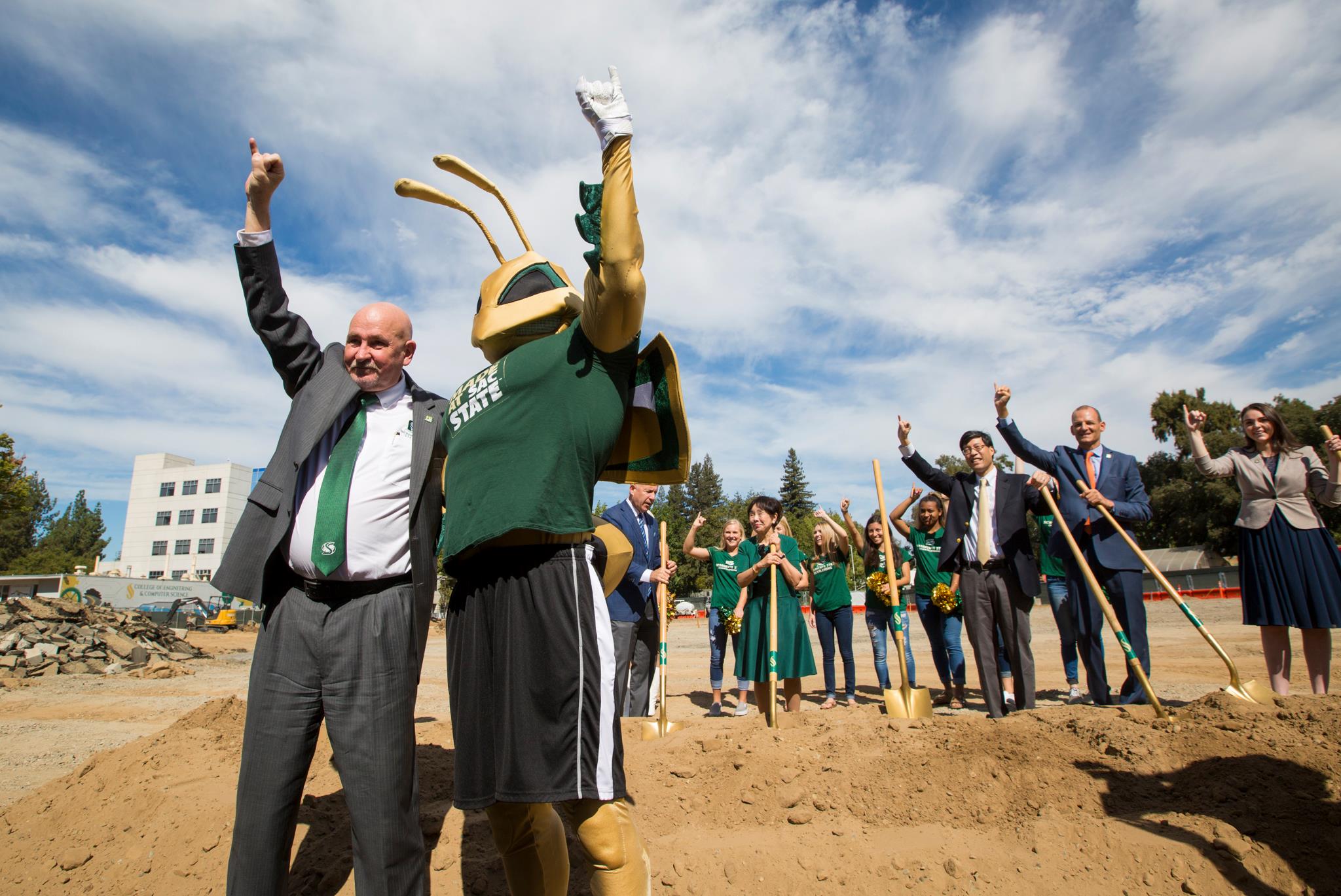Robert S. Nelsen recalled his first visit to Sequoia Hall shortly after becoming Sacramento State’s president two years ago.
“The Bunsen burners didn’t work, so they were using hair dryers from Target to heat the chemicals,” he said at the formal groundbreaking ceremony for Sac State’s new Science Complex on Monday, Sept. 18. “That's when I knew we needed a new science building.”
Sacramento Mayor Darrell Steinberg, who followed Nelsen to the podium, joked: “Today is a bad day for the hair dryer industry.”
 President Robert S. Nelsen joins Herky in a "Stingers Up!" after the ceremonial groundbreaking. (Sacramento State/Jessica Vernone) More photos
President Robert S. Nelsen joins Herky in a "Stingers Up!" after the ceremonial groundbreaking. (Sacramento State/Jessica Vernone) More photosMore than 350 cheering students, faculty, staff, dignitaries, and other friends of the University were on hand to ceremonially kick off construction of the $91 million Science Complex. It’s scheduled for completion in June 2019. The construction site is south of Guy West Bridge, next to Hornet Bookstore.
The sleek, 96,631-square-foot structure overlooking the American River will have glass-walled research and teaching labs, putting science on display to the outside world. It will be the first new classroom building erected since Mariposa Hall in 2000 and will set a standard for educating tomorrow’s scientists and engaging the greater Sacramento community.
The state-of-the-art complex will have 30 cutting-edge biology and chemistry labs outfitted with the latest instruments; a 2,500-square-foot planetarium with 120 seats for full-dome, high-definition “sky shows”; and a roll-back rooftop observatory housing Sac State’s two telescopes for viewing the night sky.
Among those who wielded golden shovels at the groundbreaking ceremony were Congresswoman Doris Matsui, Assemblyman Kevin McCarty, state Sen. Richard Pan, and Sacramento State Provost Ching-Hua Wang, in addition to Nelsen and Steinberg.
“With this groundbreaking,” Matsui said, “Sac State is taking a bold step for the future, planting the flag as a hub for STEM education, and letting everyone know that innovation happens here. … I can’t wait to come back for the ribbon-cutting two years from now.”
Pan called Sacramento State “a huge leader for the Sacramento region.” McCarty, who was “Made at Sac State,” noted that the Science Complex will help students graduate in four years. And Steinberg said that the “building is a signal to young people that they matter, and if they’re interested in a career in science, choose Sac State, because you can’t do any better than this.”
And Mia Kagianas, president of Associated Students, Inc. (ASI), and the ceremony’s emcee, likened the groundbreaking to a 1950s photograph of Walt Disney – a man with a dream – standing on the bare ground that would become “the Happiest Place on Earth.”
“The Science Complex is our Disneyland,” she said.
Among the features of the five-story Science Complex:
- It will meet the U.S. Green Building Council’s LEED Gold certification standards.
- A 235-pound polished cast brass Foucault pendulum will hang from the lobby ceiling and mark the Earth’s 24-hour rotation. It also will serve as an art piece for the building. The pendulum was the gift of the late Chien Yuan Hu, a Sac State professor of astronomy from 1966 to ’92.
- The Science Plaza will feature educational displays of interest to schoolchildren and the Sac State community.
- Visitors to the second-floor rooftop “green terrace” will be able to see the pendulum’s movement through a skylight.
- The terrace is a sustainable mini park that will help to insulate a section of the building and capture storm water runoff.
- Outdoor benches and tables, and cladding in the lobby and student alcoves, will be made from campus trees that were removed for PG&E’s gas pipeline upgrade.
- Clustered laboratory spaces will increase collaboration among the various academic disciplines.
- Shared study spaces will allow students to interact with each other outside the classroom.
- 90 percent of Sacramento State’s students, no matter their major, will be able to take classes in the Science Complex.
The California State University (CSU) allocated $70.5 million for the Science Complex. Sacramento State is raising $20 million from private sources for equipment and furnishings.
Matsui and her husband, the late Congressman Robert T. Matsui, secured nearly $1.5 million in congressional earmarks for an earlier iteration of the Science Complex.
In the early 2000s, Sac State drew up preliminary plans and concepts for what was to be called the Science and Space Center. The project went through additional planning phases, and in 2004, Robert Matsui secured $500,000 in federal funds for the building. A year later, Congresswoman Matsui secured $950,000 for a planetarium. The recession delayed state funding, and the center was never built.
Donors have the chance to leave their mark on the Science Complex and the success of future scientists. Naming opportunities include the two lecture halls ($500,000 each), green terrace ($1 million), plaza ($2 million), observatory ($2.5 million), and the planetarium ($5 million.) Gift levels begin at $10,000. – Dixie Reid
In the Media:
"Sac State to break ground on $90 million science complex," Sacramento Bee
"Darrell Steinberg, Sac State officials break ground on $90 million science complex," Sacramento Bee
"Sacramento State Science Complex finally sees groundbreaking," CBS 13
"Sac State to build planetarium in new science complex," KCRA 3
